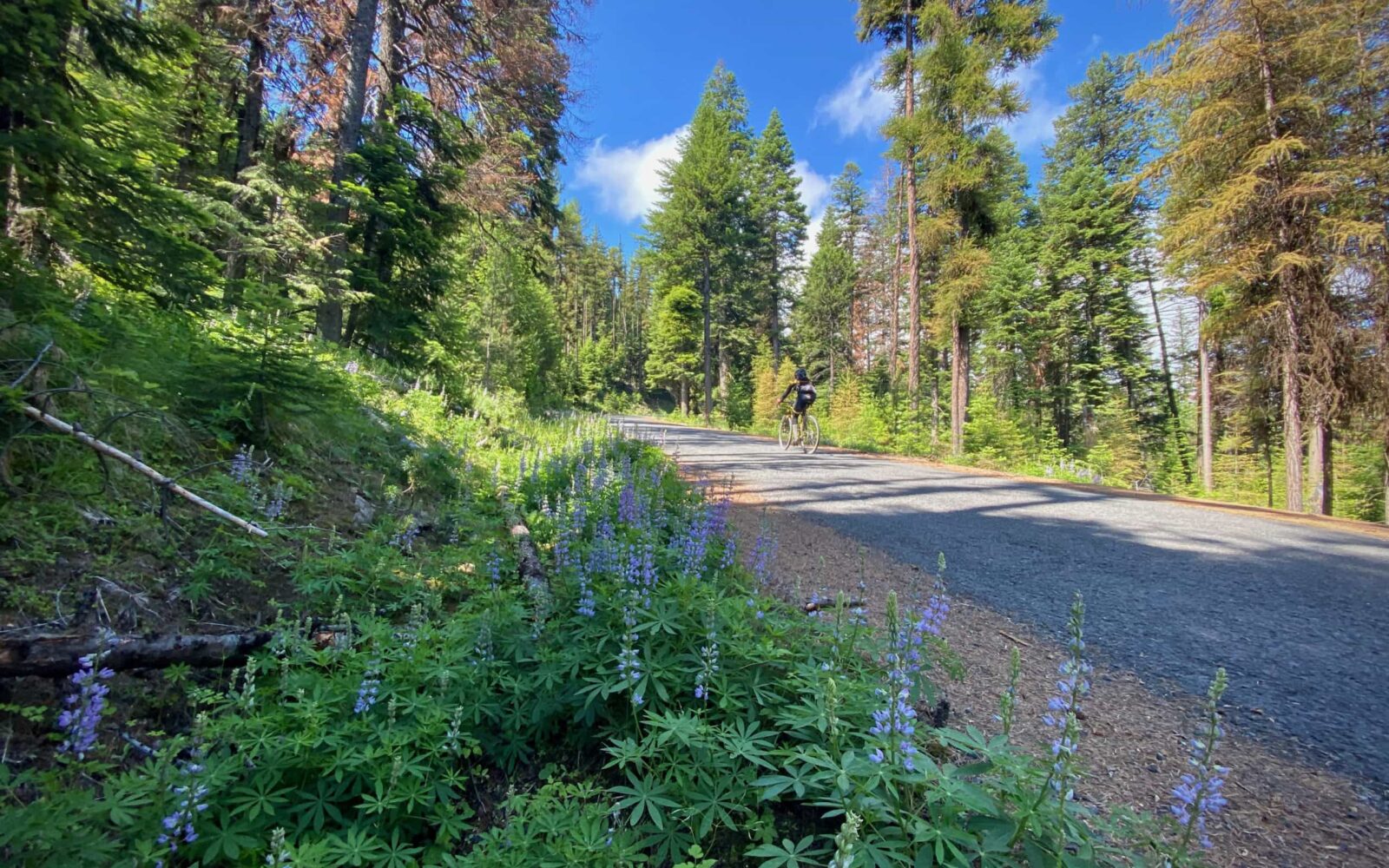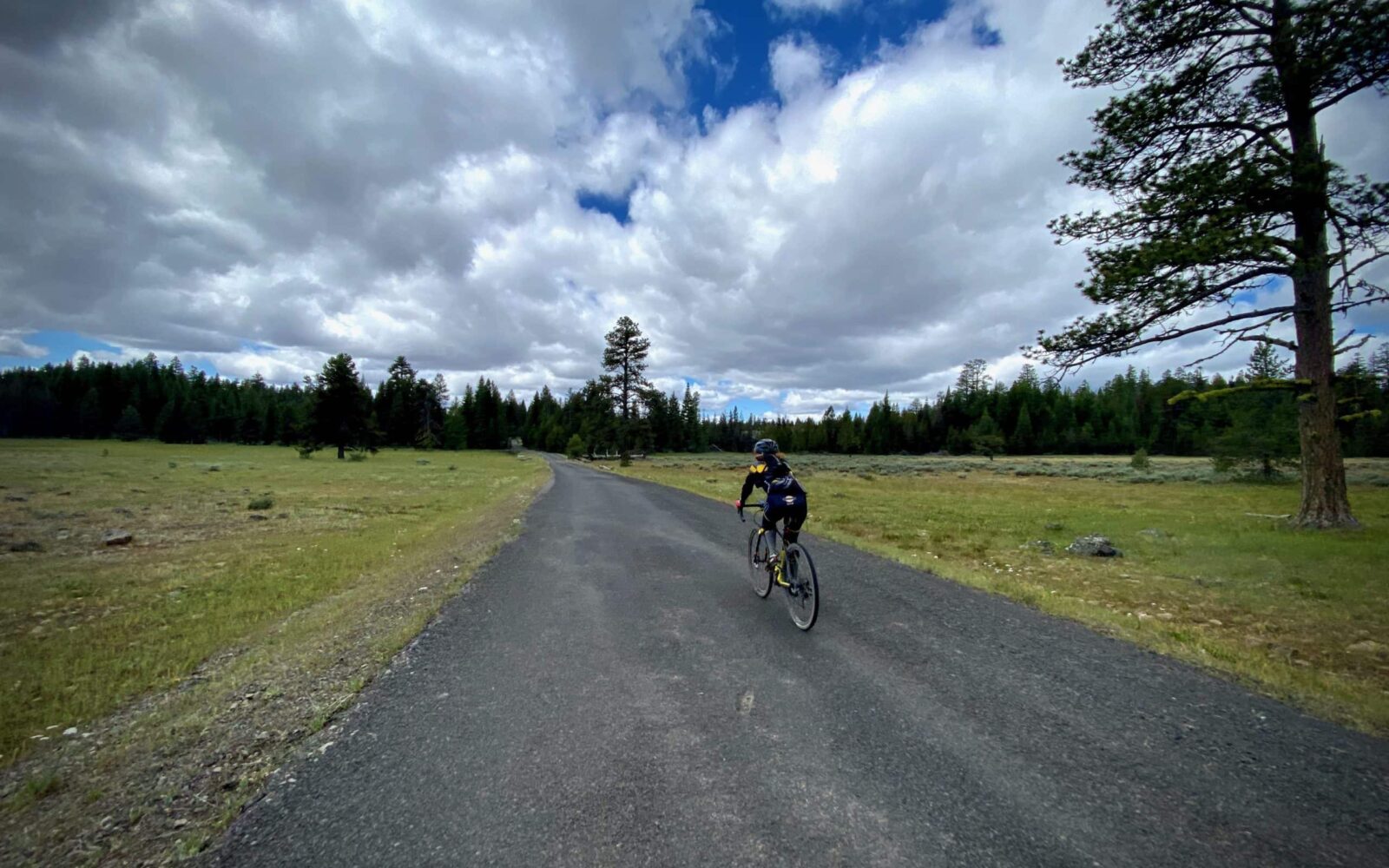Broadway Lava
Caution! We do not provide turn-by-turn directions in our GPX files. Those are auto-generated by your bike computer and are usually less than 70% accurate. Learn more.
For help loading a GPX file onto your bike computer, go here.
DownloadWhen We Like to Ride This
On a 70+ degree day, in early to mid-July after a couple of weeks of dry weather. The sector from mile 11 to mile 18, needs time to dry out. Even after several weeks of no rain, we encountered large puddles of water. Error on the side of caution, this sector could be a long, muddy hike a bike. If the mud is sticking to your wheels, turn around. The road conditions will not get better for a long time!
Terrain & Riding
Miles 0 to 5 / The Climb / Paved
From the parking area, continue out the one-lane paved road, climbing for the next 4 miles gaining 1500 feet, an average gradient of 7%. Some of the steepest gradients are found near the top of the climb, ~ 10%. Most of the climbing is through Ponderosa forests, but there are several peek-a-boo views to the north of the high desert rangelands below (~ 4000 feet elevation). Note that the first 2.5 miles (up to the cattle guard) are through private lands, with a public easement for the road.
Miles 5 to 11 / High Alpine Rollers / Paved & Gravel
As the climb tops out, the pavement continues. This sector rolls up and down small inclines, past high alpine meadows (at ~ 6000 feet), and through the forest. micro-video At ~ mile 5, make a right hand turn onto NF 2630, the old Summit Trail.
The old Summit Trail. It was the stock driveway for moving sheep and cattle across the forest in the early 1900s. It started as a pack trail with the creation of the Blue Mountain forest preserve and was later used to connect the many fire lookouts in the area. [from Kiosk at Scott’s Corner in the Ochoco National Forest]
At mile 8.5, the road surface changes to gravel, hard-packed and smooth riding. On this sector, we saw a couple of wild turkeys, and the Lupine were in full bloom (July 1).
Mile 11 to 20 / Loamy Forests and Gray Lava Rock / Primitive Forest Service Roads
At mile 10.7, you come to an intersection with NF 725. The route goes straight (west), NF 2630. The road is primitive, [micro-video] and the next 6 miles are the crux of the ride. Loamy soils with puddles and wheel ruts, ancient volcanic lava flows with gray volcanic chunk the size of golf balls, [micro-video] and big shale rocks the size of your fist filling in mud sections of the road. These fill-in sections are short, 20 or 30 yards in length, but there are 6 to 8 of them in the latter part of the sector.
The first lava flow you cross is the Broadway flow; the second is the Peterson flow. At mile 12.5, near the end of the Peterson lava flow, there is a tuft of black volcanic rock to your left. Follow the beaten in trail to the highpoint. This provides a view of the entire flow. Quite unique.
50 to 70 million years ago, central Oregon volcanoes deposited layers of lava and ash up to 1,000 feet (300 m) thick over the area that is now the Ochoco Mountains. [Wikipedia]
The Ochoco National Forest is a much older volcanic region, than the Deschutes National Forest, that has been uplifted and eroded. [National Forest Foundation]
At mile 16, make a hard left onto NF 100. Don’t miss this turn! The road remains primitive and begins a steep descent. 1300 feet of elevation loss in 5 miles. Along the way, you will come to areas of the road filled in with fist-size rock to compensate for sections of road that remained boggy and muddy for most of the summer. These fill-ins are short in distance, maybe 20 to 30 yards in length. They are rideable, but it may take a foot dab or two to stay upright.
In the distance [mile 17], at about your 1 to 2 o’clock position will be Big Summit Prairie. Just when you have had enough of these cobbled fill-ins (11), the road goes to hard-packed, fast gray pea gravel [mile 17+]. (We have a route devoted exclusively to Big Summit Prairie.)
Big Summit Prairie is known for its diversity of wildflowers and birds. Privately owned, the prairie is surrounded by U.S. Forest Service and Bureau of Land Management. The prairie is a five-by-seven-mile basin at an elevation of 4,500 feet, and is described by Stuart G. Garrett as an “unexpected meadow island in the dramatic old-growth ponderosa pine forests.” [The Oregon Encyclopedia]
As you drop elevation, the terrain changes to scattered Juniper and high desert rangelands. Many of the Junipers are colored in bright fluorescent green Wolf moss and/or black hanging Wila moss. At ~ mile 19.5, merge onto a larger gravel road, NF 3050. It feels like a superhighway! The downhill continues until just past mile 20.
Miles 20 to 37 / Red Earth and Ponderosa Forests / Gravel
At mile 20.3 make a hard left, almost a full U-turn, onto NF 50. This is a primitive gravel road.
The next 17 miles is a mix of Ponderosa forests, and ancient lava flows of red earth and grasses. This sector is undulating with a net gain of 2000 feet and a loss of 1200 feet.
At mile 21.8, the route takes the right leg of a Y intersection. The section is double track with some rocky gnar and a stream crossing. However, it is short, only 0.7 miles in length. At mile 22.5, it is back to pea gravel and winding through Ponderosa forests.
At ~ mile 25, go left onto NF 30. This is a big, wide gravel road, the main road through this area of the Ochoco National Forest. To your left will be the Jones lava flow.
Just after mile 27, bear left onto a secondary gravel road, but in good condition. Crazy Creek is to the right, and lava flows are to the left. The road initially climbs at 3%, pitching up and becoming more primitive the higher it climbs. The climb is relatively short, 2.5 miles with 600 feet of gain, topping out on a lava field. The last mile is through a lava field [micro-video] and the very last 100 yards is very primitive. Follow your GPS breadcrumb track, and it will lead you to an unused forest service road. It is gated at the exit.
The color of lava depends on the temperature of the flow as well as the chemical composition and any impurities that are in the liquid rock. Colors can include black, red, gray, brown and tan, metallic sliver, pink, and green. [Instant Hawaii]
This section of road is fun riding. Rolling. Flowy. In and out of the forest canopy. At mile 32.4 there is a green gate you need to walk around.
At mile 34, go left onto NF 30 (again). Ride past more lava flows. Just after mile 36, the end of the climbing for the day is marked by the “lip”. It is quite visible from a distance. It is a short, steep burst of climb kicking up to 8%, but only with a gain of 250 feet.
Miles 37 to Finish / Fast and Fun Downhill / Paved
At mile 37, make the left onto NF 12. Paved. It is easy street from here on. Zip past a few meadows on the flats, then at mile 38.4, move into the drops and begin the fast, paved descent to the finish. In the first half of the descent, there are some sweeping views of the east Mitchell rangelands. [micro-video]
The Start
The second pull out along NF-12, on the right hand side. The pull out just before the “Curvy road next 4 miles” sign. Do not park off the road as this is private land.
Food & Water
- None.
Route Notes
The minimum tire we would take on this route is 45 mm. Some will find 50+ mm tires a better choice. Depends on your comfort level with rough and gnarly!
Like most gravel routes, there will be times when you are over-biked and times when you are under-biked.
Over-biked is when you’re riding a bike that’s more rugged than the terrain requires—think full-suspension mountain bike on a smooth gravel road. It’ll handle the route just fine, but it might feel slow and sluggish.
Under-biked is the opposite—your bike is lighter and faster but not quite built for the rough stuff. Picture a skinny-tired gravel rig tackling chunky rock sections. You’ll still get through, but you’ll feel every bump and need to pick your lines carefully.
The entire route, except the beginning climb and ending descent, is above 4800 feet. Plan accordingly.
Moderate+ difficulty. Miles 11 to 18 are:
- Rough and gnarly requiring good technical skills
- Quite remote and difficult to access, we saw no one
- Little to no cell phone reception
Route Options
Avoiding Sector Miles 27 to 33
Based on Marcella’s comment (date July 2025) and that this sector is quite primitive and challenging to navigate, we’ve provided a bypass. If you try this version (2.0), please share your experience in the comments. Additionally, with this change, it might be better to ride the route in the opposite direction—specifically, clockwise.
- Route Map: Broadway Lava (v2.0 with bypass)
- GPX File: Download



























 Behind every route is scouting, mapping, storytelling, and a whole lot of pedal power.
Behind every route is scouting, mapping, storytelling, and a whole lot of pedal power.
Have you ridden this route? Got a question? Join the discussion!